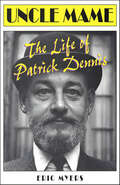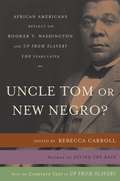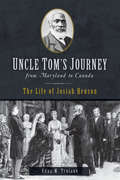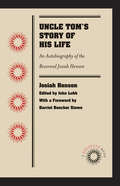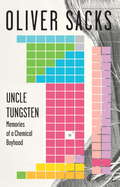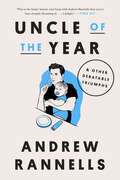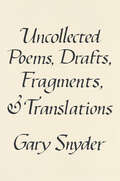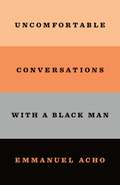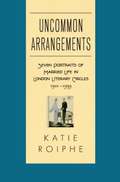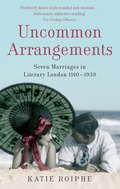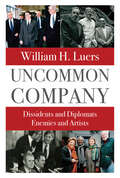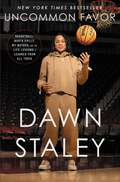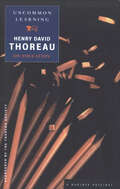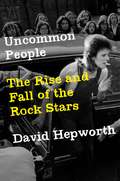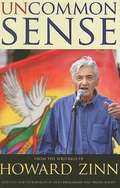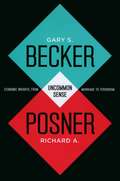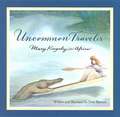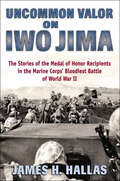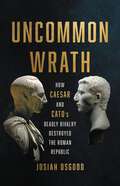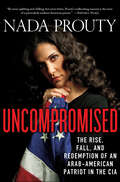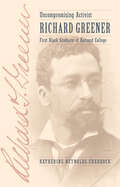- Table View
- List View
Uncle Mame: The Life of Patrick Dennis
by Eric MyersEdward Everett Tanner III, under his pseudonyms of Patrick Dennis and Virginia Rowans, was the author of sixteen novels - most of them bestsellers - including the classics Little Me and Genius. But, despite the success of his other works, he is by best known and best remembered for his most indelible creation - Auntie Mame. Born and raised in the affluent suburbs of Chicago, Tanner moved to New York City after World War II and embarked upon a writing career. His first two books were published with a whimper - attracting few reviews and fewer sales - and his third book was rejected by nineteen publishers before being accepted at a relatively small house. But Auntie Mame became a phenomena spending two years on the bestseller lists, adapting into a successful play, movie, and later a musical. As a result of this and later successes, Tanner made millions and became the toast of a certain bohemian segment of Manhattan arts society. He also spent every cent he ever made. Torn between his wife and family and his own awakening realization of his homosexuality, he separated from his wife and moved to Mexico. By the early 70's, his writing career over, he embarked upon a new career - as a butler to some of the wealthiest families in America.Based on extensive interviews with co-workers, friends, and relatives, Uncle Mame is a revealing, appealing portrait of a great American character. Easily the counterpart of such revered wits as P. G. Wodehouse and Evelyn Waugh, Dennis is not only the man who brought camp to the American mainstream but he also lived a life as wild, poignant, madcap, and intriguing as any of his own books.
Uncle Tom or New Negro?: African Americans Reflect on Booker T. Washington and UP FROM SLAVERY 100 Years Later
by Rebecca CarrollOn the ninetieth anniversary of Booker T. Washington's death comes a passionate, provocative dialogue on his complicated legacy, including the complete text of his classic autobiography, Up from Slavery.Booker T. Washington was born a slave in 1858, yet roughly forty years later he had established the Tuskegee Institute. Befriended by a U.S. president and corporate titans, beloved and reviled by the black community, Washington was one of the most influential voices on the postslavery scene. But Washington's message of gradual accommodation was accepted by some and rejected by others, and, almost a century after his death, he is still one of the most controversial and misunderstood characters in American history. Uncle Tom or New Negro? does much more than provide yet another critical edition of Washington's memoirs. Instead, Carroll has interviewed an outstanding array of African American luminaries including Julianne Malveaux, cultural critics Debra Dickerson and John McWhorter, and Pulitzer Prize-winning journalist and radio talk-show host Karen Hunter, among others. In a dazzling collection bursting with invigorating and varying perspectives, (e.g. What would Booker T. think of Sean Combs or Russell Simmons? Was Washington a "tragic buffoon" or "a giver of hope to those on the margins of the margins"?) this cutting-edge book allows you to reach your own conclusions about a controversial and perhaps ultimately enigmatic figure.From the Trade Paperback edition.
Uncle Tom's Journey from Maryland to Canada: The Life of Josiah Henson (American Heritage)
by Edna M. Troiano“The true story behind Uncle Tom’s Cabin . . . the real story of his escape is more moving, and more harrowing, than anything one could put in fiction.” —Yesterday’s AmericaJosiah Henson was born into slavery in La Plata, Maryland, and auctioned off as a child to pay his owner’s debt. After numerous trials and abuse, he earned the trust of his slaveholder by exhibiting intelligence and skill.Daringly, he escaped to Canada with his wife and children. There he established a settlement and school for fugitives and repeatedly returned to the United States to help lead others to freedom along the Underground Railroad. He published a bestselling autobiography and became a popular preacher, lecturer, and international celebrity. He is immortalized as the inspiration for the title character in Harriet Beecher Stowe’s Uncle Tom’s Cabin. Author Edna M. Troiano recounts the amazing life of Maryland’s Josiah Henson and explores the sites devoted to his memory.“[An] intriguing examination of another heroic individual, Josiah Henson. Born in 1789, in Maryland, Henson was the abolitionist Harriet Beecher Stowe’s primary inspiration for Uncle Tom’s Cabin.” —Literary Review of Canada
Uncle Tom's Story of His Life
by Josiah HensonThis 1876 version of Josiah Henson's autobiography, the first of many editions issued by British editor John Lobb, followed the original 1849 edition and a much-expanded 1858 version. The autobiography traces Henson's life from his birth into slavery in Maryland in 1789; his escape to Canada in 1830; his participation in the founding of the Dawn Settlement for fugitive slaves in Ontario; and his several trips to England to raise funds for the settlement. Henson, who in his later years toured as the model for the Uncle Tom of Harriet Beecher Stowe's novel, describes his meeting with Stowe in 1852 and draws parallels between the histories of other Uncle Tom's Cabin characters and his own acquaintances. While Stowe herself stressed that there was no single model for her title character, she called Henson a "parallel instance" for Uncle Tom in A Key to Uncle Tom's Cabin. Reprinted multiple times in the United States and Britain in the nineteenth century and translated into several other languages, Henson's autobiography continues to reward readers with its descriptions not only of slave life in Maryland and Kentucky, but also of the business and educational ventures of escaped slaves in Ontario.
Uncle Tungsten: Memories of a Chemical Boyhood
by Oliver SacksFrom the distinguished neurologist who is also one of the most remarkable storytellers of our time—a riveting memoir of his youth and his love affair with science, as unexpected and fascinating as his celebrated case histories.&“A rare gem…. Fresh, joyous, wistful, generous, and tough-minded.&” —The New York Times Book ReviewLong before Oliver Sacks became the bestselling author of The Man Who Mistook His Wife for a Hat and Awakenings, he was a small English boy fascinated by metals—also by chemical reactions (the louder and smellier the better), photography, squids and cuttlefish, H.G. Wells, and the periodic table. In this endlessly charming and eloquent memoir, Sacks chronicles his love affair with science and the magnificently odd and sometimes harrowing childhood in which that love affair unfolded.In Uncle Tungsten we meet Sacks&’ extraordinary family, from his surgeon mother (who introduces the fourteen-year-old Oliver to the art of human dissection) and his father, a family doctor who imbues in his son an early enthusiasm for housecalls, to his &“Uncle Tungsten,&” whose factory produces tungsten-filament lightbulbs. We follow the young Oliver as he is exiled at the age of six to a grim, sadistic boarding school to escape the London Blitz, and later watch as he sets about passionately reliving the exploits of his chemical heroes—in his own home laboratory. Uncle Tungsten is a crystalline view of a brilliant young mind springing to life, a story of growing up which is by turns elegiac, comic, and wistful, full of the electrifying joy of discovery.
Uncle of the Year: & Other Debatable Triumphs
by Andrew RannellsFrom the star of The Book of Mormon and Girls, candid, hilarious essays on anxiety, ambition, and the uncertain path to adulthood that ask: How will we know when we get there? &“With the unsparing eye of David Sedaris and the social wisdom of Nora Ephron, Andrew Rannells tackles the most foundational questions of growing up.&”—Lena DunhamIn Uncle of the Year, Andrew Rannells wonders: If he, now in his forties, has everything he&’s supposed to need to be an adult—a career, property, a well-tailored suit—why does he still feel like an anxious twenty-year-old climbing his way toward solid ground? Is it because he hasn&’t won a Tony, or found a husband, or had a child? And what if he doesn&’t want those things? (A husband and a child, that is. He wants a Tony.) In deeply personal essays drawn from his life as well as his career on Broadway and in Hollywood, Rannells argues that we all pretend—for friends, partners, parents, and others—that we are constantly succeeding in the process known as &“adulting.&” But if this acting is leaving us unfulfilled, then we need new markers of time, new milestones, new expectations of what adulthood is and can be. Along the way, Rannells navigates dating, aging, mental health, bad jobs, and much more. In his essay &“Uncle of the Year,&” he explores the role that children play in his life, as a man who never thought having kids was necessary or even possible—until his siblings have kids and he falls in love with a man with two of his own. In &“Always Sit Next to Mark Ruffalo,&” he reveals the thrills and absurdities of the awards circuit, and the desire to be recognized for one&’s work. And in &“Horses, Not Zebras,&” he shares the piece of wisdom that helped him finally come to terms with his anxiety and perfectionism. Filled with honest insights and a sharp wit, Uncle of the Year challenges us to take a long look at who we&’re pretending to be, who we know we are, and who we want to become.
Uncollected Poems, Drafts, Fragments, and Translations
by Gary SnyderA collection of previously uncollected and unpublished works by a Pulitzer Prize-winning Beat poet Gary Snyder, written during his most productive and important yearsFar from being a simple miscellany of poems, Uncollected Poems, Drafts, Fragments, and Translations contains some of Gary Snyder&’s best work, written during his most productive and important years.Many of these have been published in magazines or as broadsides, including Spel Against Demons, Dear Mr. President, Hymn to the Goddess San Francisco, Smokey the Bear Sutra, A Curse on the Men in Washington, Pentagon. The collection also includes a great number of translations from Chinese and Japanese poets. Much of this work has been gleaned from journals, manuscripts and correspondence, and never before published in any form.
Uncomfortable Conversations With a Black Man
by Emmanuel AchoIn Uncomfortable Conversations With a Black Man, the author takes on all the questions, large and small, insensitive and taboo, many white Americans are afraid to ask―yet which all Americans need the answers to, now more than ever. With the same open-hearted generosity that has made his video series a phenomenon, the author explains the vital core of such fraught concepts as white privilege, cultural appropriation, and “reverse racism.” In his own words, he provides a space of compassion and understanding in a discussion that can lack both. He asks only for the reader’s curiosity―but along the way, he will galvanize all of us to join the antiracist fight.
Uncommon Arrangements: Seven Marriages in Literary London 1910 -1939
by Katie RoipheKatie Roiphe's stimulating work has made her one of the most talked about cultural critics of her generation. Now this bracing young writer delves deeply into one of the most layered of subjects: marriage. Drawn in part from the private memoirs, personal correspondence, and long-forgotten journals of the British literary community from 1910 to the Second World War, here are seven "marriages à la mode"---each rising to the challenge of intimate relations in more or less creative ways. Jane Wells, the wife of H.G., remained his rock, despite his decade-long relationship with Rebecca West (among others). Katherine Mansfield had an irresponsible, childlike romance with her husband, John Middleton Murry, that collapsed under the strain of real-life problems. Vera Brittain and George Gordon Catlin spent years in a "semidetached" marriage (he in America, she in England). Vanessa Bell maintained a complicated harmony with the painter Duncan Grant, whom she loved, and her husband, Clive. And her sister Virginia Woolf, herself no stranger to marital particularities, sustained a brilliant running commentary on the most intimate details of those around her. Every chapter revolves around a crisis that occurred in each of these marriages---as serious as life-threatening illness or as seemingly innocuous as a slightly tipsy dinner table conversation---and how it was resolved...or not resolved. In these portraits, Roiphe brilliantly evokes what are, as she says, "the fluctuations and shifts in attraction, the mysteries of lasting affection, the endurance and changes in love, and the role of friendship in marriage." The deeper mysteries at stake in all relationships.
Uncommon Arrangements: Seven Marriages in Literary London 1910 -1939
by Katie RoipheDrawing on the memoirs, letters and diaries of a group of British intellectuals writing between 1910 and the Second World War, UNCOMMON ARRANGEMENTS paints a witty and insightful portrait of seven 'marriages a la mode', each triumphantly casting off Victorian inhibitions and pursuing bohemian ideals of freedom and equality.But as well as love and passion, there were tolerance, denial, anger, jealousy and drama. The Bloomsbury group's Clive and Vanessa Bell opened up their marriage to accommodate Vanessa's live-in lovers, and Clive's obsession with his sister-in-law, Virginia Woolf. H.G. Well's steadfast wife sent her love to his mistress Rebecca West when their son was born. And Vera Brittain and Katherine Mansfield, more devoted to their work than to their husbands, wrestled with unfulfilled desires.This is both a fascinating exploration of love, affection and friendship in marriage, and a brilliantly entertaining account of a dazzling era of high-society high living.
Uncommon Arrangements: Seven Marriages in Literary London 1910 -1939
by Katie RoipheDrawing on the memoirs, letters and diaries of a group of British intellectuals writing between 1910 and the Second World War, UNCOMMON ARRANGEMENTS paints a witty and insightful portrait of seven 'marriages a la mode', each triumphantly casting off Victorian inhibitions and pursuing bohemian ideals of freedom and equality.But as well as love and passion, there were tolerance, denial, anger, jealousy and drama. The Bloomsbury group's Clive and Vanessa Bell opened up their marriage to accommodate Vanessa's live-in lovers, and Clive's obsession with his sister-in-law, Virginia Woolf. H.G. Well's steadfast wife sent her love to his mistress Rebecca West when their son was born. And Vera Brittain and Katherine Mansfield, more devoted to their work than to their husbands, wrestled with unfulfilled desires.This is both a fascinating exploration of love, affection and friendship in marriage, and a brilliantly entertaining account of a dazzling era of high-society high living.
Uncommon Company: Dissidents and Diplomats, Enemies and Artists
by William H. LuersAmbassador William Luers takes us on a fascinating journey from Springfield, Illinois, to Naples, Moscow, Washington DC, Venezuela, and Czechoslovakia, and then to his presidency at the Metropolitan Museum of Art, adventures in Cuba, and thereafter. In his revelatory memoir Uncommon Company, William Luers shares stories of his incredible career as a US diplomat to European and Latin American nations, where he introduced art and culture to forge common ground and community, improving the lives of citizens in many countries closed to Western ideas. From touring the Soviet Union with playwright Edward Albee in the 1960s to bringing such famous writers and artists as John Updike, Arthur Miller, William Styron, Peter Matthiessen, Francine du Plessix Gray, Richard Diebenkorn, and Frank Stella to Venezuela and Prague during his ambassadorships in Venezuela and Czechoslovakia, Bill Luers&’ practice of cultural diplomacy became known as his ability to wield &“soft power&” that strengthened US relationships wherever he served. After more than thirty years with the State Department, Luers brought his art expertise to New York&’s Metropolitan Museum of Art as its president, where he secured the Annenberg Collection of Impressionist and Post-Impressionist works by such masters as Van Gogh, Picasso, and Cézanne, among many other accomplishments. Uplifting and inspirational, William Luers&’ Uncommon Company is the true story of a life well lived, celebrating the challenges and triumphs found in the virtues of being a servant leader.
Uncommon Favor: Basketball, North Philly, My Mother, and the Life Lessons I Learned from All Three
by Dawn StaleyFor the first time, Dawn Staley shares powerful and inspiring stories that have shaped her journey on and off the court. <P> A three-time Olympic gold medalist, six-time WNBA All-Star, and the first person to win the Naismith College Player of the Year award as both a player and coach, Staley has shattered expectations at every level of the game. While her name resonates with both longtime WNBA fans and newcomers, she has kept her personal life private. <P> Uncommon Favor reveals the journey that led to Staley’s success, including the challenges she faced. From dealing with sexism on the court to feeling isolated in new environments, Staley honed her skills and learned valuable life lessons about mental fortitude and maturity that have grounded her throughout her career. <P> Beginning with her humble origins on the North Philadelphia basketball court and her rise to national fame at the University of Virginia—where she led her team to three Final Fours—Staley recounts the key moments that shaped her winning mindset. Staley’s iconic career in the WNBA and her groundbreaking coaching journey at the University of South Carolina highlight the milestones and turning points that have defined her success, both on and off the court. Fearless and authentic, Uncommon Favor shares the rewards of leading with conviction and the courage to redefine the limits of what is possible. <b>New York Times Bestseller</b>
Uncommon Learning: Henry David Thoreau on Education (Spirit of Thoreau)
by Henry David Thoreau"It is only when we forget our learning that we begin to know," Thoreau wrote. Ideas about education permeate Thoreau's writing. Uncommon Learning brings those ideas together in a single volume for the first time.
Uncommon People: The Rise and Fall of The Rock Stars
by David HepworthNamed one of the best music books of 2017 by The Wall Street JournalAn elegy to the age of the Rock Star, featuring Chuck Berry, Elvis, Madonna, Bowie, Prince, and more, uncommon people whose lives were transformed by rock and who, in turn, shaped our cultureRecklessness, thy name is rock.The age of the rock star, like the age of the cowboy, has passed. Like the cowboy, the idea of the rock star lives on in our imaginations. What did we see in them? Swagger. Recklessness. Sexual charisma. Damn-the-torpedoes self-belief. A certain way of carrying themselves. Good hair. Interesting shoes. Talent we wished we had. What did we want of them? To be larger than life but also like us. To live out their songs. To stay young forever. No wonder many didn’t stay the course.In Uncommon People, David Hepworth zeroes in on defining moments and turning points in the lives of forty rock stars from 1955 to 1995, taking us on a journey to burst a hundred myths and create a hundred more.As this tribe of uniquely motivated nobodies went about turning themselves into the ultimate somebodies, they also shaped us, our real lives and our fantasies. Uncommon People isn’t just their story. It’s ours as well.
Uncommon Sense from the Writings of Howard Zinn
by Howard ZinnThis volume collects short quotations from across the works of Howard Zinn, the leftist American historian perhaps best known for his A People's History of the United States. The quotations generally read as aphorisms (e. g. "History is not inevitably useful. It can bind us or free us." and "At its worst, war has been mass slaughter without even the saving grace of a definable social goal.") that together provide a broad overview of Zinn's thinking on (citing the chapter titles): history, government, war and peace, class, racism and resistance, law and justice, Marxism and anarchism, and taking action.
Uncommon Sense: Economic Insights, from Marriage to Terrorism
by Richard A. Posner Gary S. BeckerA commentary on current events and economic issues, gathering the authors' most important and innovative entries.
Uncommon Traveler
by Don BrownMary Kingsley spent her childhood in a small house on a lonely lane outside London, England. Her mother was bedridden, her father rarely home, and Mary served as housekeeper, handyman, nursemaid, and servant. Not until she was thirty years old did Mary get her chance to explore the world she’d read about in her father’s library. In 1893, she arrived in West Africa, where she encountered giant Xying insects, crocodiles, hippos, and brutal heat. Mary endured the hardships of the equatorial country-and thrived.
Uncommon Traveler: Mary Kingsley In Africa (Into Reading, Trade Book #2)
by Don BrownNIMAC-sourced textbook <p><p> Mary Kingsley spent her childhood in a small house on a lonely lane outside London, England. Her mother was bedridden, her father rarely home, and Mary served as housekeeper, handyman, nursemaid, and servant. Not until she was thirty years old did Mary get her chance to explore the world she’d read about in her father’s library. In 1893, she arrived in West Africa, where she encountered giant Xying insects, crocodiles, hippos, and brutal heat. Mary endured the hardships of the equatorial country—and thrived.
Uncommon Traveler: Mary Kingsley in Africa
by Don BrownBiography of a 19th-century Englishwoman who, after a secluded childhood, traveled alone through unexplored West Africa in 1893-1894, learning much about the area and its people.
Uncommon Valor on Iwo Jima: The Stories of the Medal of Honor Recipients in the Marine Corps' Bloodiest Battle of World War II
by James H HallasThe epic Battle of Iwo Jima is recounted through the stories of twenty-eight American soldiers who showed uncommon valor during one of WWII&’s most bitter conflicts. When the smoke cleared on Iwo Jima in March of 1945, nineteen-thousand American Marines had been wounded and seven-thousand were dead, a casualty rate of nearly thirty-nine percent. Lasting over a month, Iwo was the Marines&’ bloodiest battle of the Second World War and the only Pacific battle in which a U.S. landing force suffered more casualties than it inflicted. It was also the most highly decorated single engagement in Marine Corps history. This volume captures the bravery of those who fought in that epic battle through the stories of twenty-two Marines and five Navy personnel who received the Medal of Honor in recognition of their gallantry under fire.
Uncommon Wisdom: True Tales of What Our Lives as Doctors Have Taught Us About Love, Faith and Hea ling
by John Castaldo Lawrence LevittIn light of the escalating costs of healthcare in the U.S. and the on-going debate about appropriate health insurance reform, it's easy to forget about the human side of medicine and the importance of the doctor-patient relationship. In Uncommon Wisdom, neurologists John Castaldo and Lawrence Levitt share what they have learned in their many years as doctors, not just from tests and labs, but from years of listening and learning from their patients. These 16 tales show doctors as human beings: flawed and full of doubt, wonder, and reverence about what it means to be alive. The stories remind us that the medical profession should be about treating people with the dignity they deserve and that medical miracles don't always involve medicine. These doctors find cures, solve mysteries, and glean many lessons from listening deeply to their patients.
Uncommon Wrath: How Caesar and Cato's Deadly Rivalry Destroyed the Roman Republic
by Josiah OsgoodA dual biography of Julius Caesar and Cato the Younger that offers a dire warning: republics collapse when partisanship overrides the common good. In Uncommon Wrath, historian Josiah Osgood tells the story of how the political rivalry between Julius Caesar and Marcus Cato precipitated the end of the Roman Republic. As the champions of two dominant but distinct visions for Rome, Caesar and Cato each represented qualities that had made the Republic strong, but their ideological differences entrenched into enmity and mutual fear. The intensity of their collective factions became a tribal divide, hampering their ability to make good decisions and undermining democratic government. The men&’s toxic polarity meant that despite their shared devotion to the Republic, they pushed it into civil war. Deeply researched and compellingly told, Uncommon Wrath is a groundbreaking biography of two men whose hatred for each other destroyed the world they loved.
Uncompromised: The Rise, Fall, and Redemption of an Arab-American Patriot in the CIA
by Nada Prouty"Nada Prouty served her country loyally, with distinction, and, as universally acknowledged by her colleagues, with great personal courage as a CIA covert officer. This tale of rampant trampling of citizen's rights is a vivid reminder of the responsibility of citizens to be vigilant against unaccountable government overreach if we hope to keep a strong democracy, where the rule of law prevails and where a citizen is presumed innocent until proven guilty." -Valerie Plame, author of Fair GameWhen Nada Prouty came to the United States as a young woman, she fell in love with the democracy and freedom of her new home. After a childhood in war-torn Lebanon with an abusive father and facing the prospect of an arranged marriage, she jumped at the chance to forge her own path in America-a path that led to exciting undercover work in the FBI, then the CIA. As a leading agent widely lauded by her colleagues, she worked on the most high-profile terrorism cases in recent history, including the hunt for Saddam Hussein and the bombing of the USS Cole, often putting her life on the line and usually getting her man.But all this changed in the wake of 9/11, at the height of anti-Arab fervor, when federal investigators charged Prouty with passing intelligence to Hezbollah. Lacking sufficient evidence to make their case in court, prosecutors went to the media, suggesting that she had committed treason. Prouty, dubbed "Jihad Jane" by the New York Post, was quickly cast as a terrorist mastermind by the relentless 24-hour news cycle, and a scandal-hungry public ate it up.Though the CIA and federal judge eventually exonerated Prouty of all charges, she was dismissed from the agency and stripped of her citizenship. In Uncompromised, Prouty tells her whole story in a bid to restore her name and reputation in the country that she loves. Beyond a thrilling story of espionage and betrayal, this is a sobering commentary on cultural alienation, the power of fear, and what it means to truly love America.
Uncompromising Activist: Richard Greener, First Black Graduate of Harvard College (The Johns Hopkins University Studies in Historical and Political Science #132)
by Katherine Reynolds ChaddockAlmost forgotten until his papers were discovered in a Chicago attic, Richard Greener was a pioneer who broke educational and professional barriers for black citizens. He was also a man caught between worlds.Richard Theodore Greener (1844–1922) was a renowned black activist and scholar. In 1870, he was the first black graduate of Harvard College. During Reconstruction, he was the first black faculty member at a southern white college, the University of South Carolina. He was even the first black US diplomat to a white country, serving in Vladivostok, Russia. A notable speaker and writer for racial equality, he also served as a dean of the Howard University School of Law and as the administrative head of the Ulysses S. Grant Monument Association. Yet he died in obscurity, his name barely remembered.His black friends and colleagues often looked askance at the light-skinned Greener’s ease among whites and sometimes wrongfully accused him of trying to "pass." While he was overseas on a diplomatic mission, Greener’s wife and five children stayed in New York City, changed their names, and vanished into white society. Greener never saw them again. At a time when Americans viewed themselves simply as either white or not, Greener lost not only his family but also his sense of clarity about race. Richard Greener’s story demonstrates the human realities of racial politics throughout the fight for abolition, the struggle for equal rights, and the backslide into legal segregation. Katherine Reynolds Chaddock has written a long overdue narrative biography about a man, fascinating in his own right, who also exemplified America’s discomfiting perspectives on race and skin color. Uncompromising Activist is a lively tale that will interest anyone curious about the human elements of the equal rights struggle.
